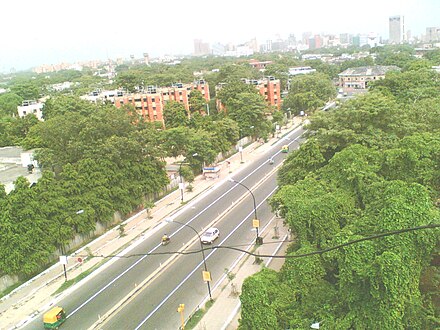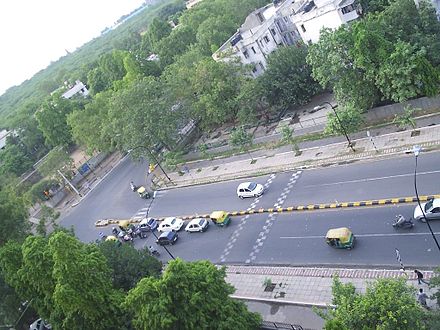Gole Market
Gole Market | |
|---|---|
| Coordinates: 28°38′01″N 77°12′20″E / 28.6337°N 77.2056°E / 28.6337; 77.2056 | |
| Country | |
| State | Delhi |
| District | New Delhi |
| Government | |
| • Body | New Delhi Municipal Corporation of Delhi |
| Languages | |
| • Official | Hindi, English |
| Time zone | UTC+5:30 (IST) |
| PIN | 110001 |
| Nearest city | Shahdara / Loni |
| Lok Sabha constituency | New Delhi Parliamentary Constituency |
| Civic agency | NDMC |

Gole Market is a neighborhood in the heart of New Delhi, India built within a traffic roundabout by Edwin Lutyens in 1921. It is one of New Delhi's oldest surviving colonial markets and is considered an architecturally significant structure. The dodecagonal market was built in the axis planned by Edwin Lutyens as part of New Delhi's layout.[1] Peshwa Road, Ramakrishna Ashram Road, Shaheed Bhagat Singh Road, and Bhai Veer Singh Road are four radial roads leading from the market.[2]
History


The octagonal market, designed by Edwin Lutyens, was built in 1921 as an important part of a wider development plan. In the years that followed, the Connaught Place shopping area was built adjacent to it, catering to the daily needs of thousands of government employees living in nearby residential areas built for them in 1925.[3] These employees worked at the nearby Secretariat Building, as most government offices had relocated from Old Delhi a decade before the new capital had been inaugurated in 1931. Many of the employees were brought into the new capital from distant parts of India, including the Bengal Presidency and Madras Presidency.[4]

After the partition of India, noted painter B.C. Sanyal and his wife Snehlata, a ghazal singer and actress moved to Gole Market. Their "refugee studio" became a hub for artists and students in New Delhi and was later known as Gallery 26. The studio later gave rise to the Delhi Shilpi Chakra, which Sanyal founded with several of her artist friends. This organisation had an important influence on the contemporary art of North India.[5][6]
By the turn of the 21st century, 28 shops operated in the market, most of them dating back to the 1920s. They included numerous confectioneries, sweet shops, and fast-food restaurants, including Kaleva, Bengali Sweet Shop, Karachi Sweet Shop, and several meat shops. Over the years, the facade deteriorated as a result of unauthorized construction and additions and was in a state of disrepair. The New Delhi Municipal Council (NDMC) fined several shopkeepers for operating without proper licenses or for unhygienic conditions.[7]
In 2007, the building was declared unsafe and the NDMC offered shopkeepers alternative shops[8] but they rejected this plan. This forced the NDMC to engage in restoration work. Later, the NDMC proposed granting full heritage status to the building and ending all commercial activities. The traffic police supported the move because running a market in the busy roundabout caused traffic congestion. By May 2009, eviction notices were served to the shopkeepers by the NDMC, which soon had six shops in its possession. The rest of the owners started a campaign against the forced move.[9][10]
Later, the NDMC revealed new plans to convert the heritage market into a museum. In February 2013, twenty-eight of the market's shopkeepers petitioned against the NDMC's alleged move to take over their shops in the Delhi High Court. On 20 June 2013, the court ruled in favor of the NDMC but cautioned it against the non-commercial use of the property. The court instructed the shopkeepers to relinquish possession of their stores by 30 June 2013.[11] On 27 June, the Supreme Court upheld the eviction date that had been ordered by the High Court.[8]
Gole Market locality
The New Delhi General Post Office which was built in 1931 is approximately 800 meters (2,600 ft) away from the Gole Market. It is also known as Gole Dak Khana due to the octagonal shape of the building. It was designed by Robert Tor Russell, the chief architect of the Public Works Department (PWD). It stands inside a busy roundabout earlier known as Alexandra Place,[12] and its height was kept low to allow a clear view of the nearby Sacred Heart Cathedral.[1]
Politics
Gole Market is located about one kilometer (0.62 mi) away from the commercial center of Connaught Place and two kilometers (1.2 mi) away from the President's House and the Parliament House. Located in close proximity to various political buildings, it also houses the Communist Party of India's Delhi headquarters.[13]
The Gole Market area was a Delhi Metropolitan Council constituency within New Delhi Lok Sabha constituency between 1966–and 1993, and later a Delhi State Assembly constituency within the South Delhi Lok Sabha constituency from 1993 to 2008. Chief Minister Sheila Dikshit contested and won the Gole Market seat in the 1998 and 2003 assembly elections.[14] However, after the delimitation exercise in 2008, the seat ceased to exist and is now the New Delhi constituency.[15]
Education
The area around Gole Market is home to a number of schools including NP Boys Senior Secondary School, Harcourt butler senior secondary school, St. Columbas School, Convent of Jesus and Mary, N P Bengali Girls Senior Secondary School, Elisabeth Hall-Shiv Niketan School, Kali Bari Dayanand Model Public School, Ranoor Paathshaala, Raisina Bengali School, Kaali Bari, NP Primary School, Kendriya Vidyalaya Gole Market, and D.T.E.A Senior Secondary School.[16]
Religious buildings
Churches:
- Sacred Heart Cathedral (Delhi, India), within the compound of Archbishop's House
- IPC Northern Region
- St. Peter's Jacobite Syrian Orthodox Cathedral
- Church of North India
- Delhi Bible Fellowship
- The Marthoma Church
Temples:
- Laxminarayan Temple (Birla Mandir)
- Kali Bari Mandir on Mandir Marg
- Hanuman Temple, Connaught Place
- Arya Samaj Mandir(Mandir marg)
Gurdwaras:
Mosques :
- Kalali Bagh Masjid, Ramakrishna Ashram Marg
References
- ^ a b "Imperial Impressions". Hindustan Times. 20 July 2011. Archived from the original on 28 February 2014.
- ^ Gole Market Delhi
- ^ "From Bengal, but staunchly Delhiites". Hindustan Times. 6 July 2011. Archived from the original on 4 December 2011.
- ^ "Capital story: Managing a New Delhi". Hindustan Times. 1 September 2011. Archived from the original on 8 December 2012.
- ^ "Art adda". Indian Express. 22 February 2009.
- ^ "B.C. Sanyal (1902 - 2003): No more brush strokes." The Hindu. 13 January 2003. Archived from the original on 12 February 2003.
{{cite news}}: CS1 maint: unfit URL (link) - ^ "Gole Market shopowners pay dearly". The Times of India. 16 February 2004. Archived from the original on 25 September 2012.
- ^ a b "SC removes hurdle for Gole Market's museum makeover". The Times of India. 28 June 2013. Archived from the original on 2 July 2013. Retrieved 28 June 2013.
- ^ "Gole Market: Road to restoration will shut its shops". Indian Express. 28 May 2009.
- ^ "Stir at Gole Mkt over eviction plan". The Times of India. 28 May 2009. Archived from the original on 25 September 2012.
- ^ "HC nod to turning Gole Market into museum". Hindustan Times. 20 June 2013. Archived from the original on 20 June 2013. Retrieved 28 June 2013.
- ^ "On World Post Day, 'lady postman' recalls old days and ways". Indian Express. 9 October 2008. Retrieved 28 June 2013.
- ^ "PM pays rich tributes to Jyoti Basu". India Today. 18 January 2010.
- ^ "Women candidates still few and far between". The Times of India. 18 November 2003. Archived from the original on 25 September 2012.
- ^ "Advani's advice convinced Jolly". Newstrack. 6 November 2008.
- ^ "Kendriya Vidyalaya Gole Market". Archived from the original on 29 October 2013. Retrieved 28 June 2013.
